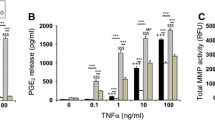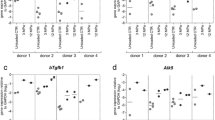Abstract
Objective and design
Determine the effect of IL-1β and dynamic compression on NFκB activation and IκB-α gene expression in chondrocyte/agarose constructs.
Methods
Constructs were cultured under free-swelling conditions or subjected to dynamic compression for up to 360 min with IL-1β and/or PDTC (inhibits NFκB activation). Nuclear translocation of NFκB-p65 was analysed by immunofluoresence microscopy. Gene expression of IκB-α, iNOS, IL-1β and IL-4 was assessed by real-time qPCR.
Results
Nuclear translocation of NFκB-p65 was concomitant with an increase in nuclear fluorescence intensity which reached maximum values at 60 min with IL-1β (p < 0.001). Dynamic compression or PDTC reduced nuclear fluorescence and NFκB nuclear translocation in cytokine-treated constructs (p < 0.001 and p < 0.01 respectively). IL-1β increased IκB-α expression (p < 0.001) at 60 min and either induced iNOS (p < 0.001) and IL-1β (p < 0.01) or inhibited IL-4 (p < 0.05) expression at 360 min. These time-dependent events were partially reversed by dynamic compression or PDTC (p < 0.01) with IL-1β. Co-stimulation by dynamic compression and PDTC favoured suppression (IκB-α, iNOS, IL-1β) or induction (IL-4) of gene expression.
Conclusions
NFκB is one of the key players in the mechanical and inflammatory pathways, and its inhibition by a biophysical/therapeutic approach could be a strategy for attenuating the catabolic response in osteoarthritis.





Similar content being viewed by others
Abbreviations
- IL-1β:
-
Interleukin-1β
- NFκB:
-
Nuclear factor-kappa B
- IκB-α:
-
Inhibitory κB-α
- iNOS:
-
Inducible nitric oxide synthase
- IL-4:
-
Interleukin-4
References
Fernandes JC, Martel-Pelletier J, Pelletier JP. The role of cytokines in osteoarthritis pathophysiology. Biorheology. 2002;39(1/2):237–46.
Berenbaum F. Signaling transduction: target in osteoarthritis. Curr Opin Rheumatol. 2004;16(5):616–22.
Malemud CJ. Protein kinases in chondrocyte signalling and osteoarthritis. Clin Orthop Relat Res. 2004;427(Suppl):145–51.
Griffin TM, Guilak F. The role of mechanical loading in the onset and progression of osteoarthritis. Exerc Sport Sci Rev. 2005;33:195–200.
Millward-Sadler SJ, Salter DM. Integrin-dependent signal cascades in chondrocyte mechanotransduction. Ann Biomed Eng. 2004;32(3):435–46.
Guilak F, Fermor B, Keefe FJ, Kraus VB, Olson SA, Pisetsky DS, et al. The role of biomechanics and inflammation in cartilage repair and injury. Clin Orthop Relat Res. 2004;423:17–26.
Vincent TL, Saklatvala J. Is the response of cartilage to injury relevant to osteoarthritis? Arthritis Rheum. 2008;58(5):1207–10.
Goldring MB, Goldring SR. Osteoarthritis. J Cell Physiol. 2007;213(3):626–34.
Saklatvala J. Inflammatory signalling in cartilage. MAPK and NFκB pathways in chondrocytes and the use of inhibitors for research into pathogenesis and therapy of OA. Curr Drug Targets. 2007;8:305–13.
Malemud CJ. Inhibitors of stress-activated protein/mitogen-activated protein kinase pathways. Curr Opin Pharmacol. 2007;7(3):339–43.
Kobayashi M, Squires GR, Mousa A, Tanzer M, Zukor DJ, Antoniou J, et al. Role of interleukin-1 and tumor necrosis factor alpha in matrix degradation of human osteoarthritic cartilage. Arthritis Rheum. 2005;52(1):128–35.
Auron PE. The interleukin 1 receptor: ligand interactions and signal transduction. Cytokine Growth Factor Rev. 1998;9(3/4):221–37.
Newton R, Stevens DA, Hart LA, Lindsay M, Adcock IM, Barnes PJ. Superinduction of COX-2 mRNA by cycloheximide and interleukin-1beta involves increased transcription and correlates with increased NF-kappaB and JNK activation. FEBS Lett. 1997;418(1/2):135–8.
Fan Z, Yang H, Bau B, Söder S, Aigner T. Role of mitogen-activated protein kinases and NFkappaB on IL-1beta-induced effects on collagen type II, MMP-1 and 13 mRNA expression in normal articular human chondrocytes. Rheumatol Int. 2006;26(10):900–3.
Liacini A, Sylvester J, Li WQ, Zafarullah M. Inhibition of IL-1 stimulated MAP kinases, AP-1 and NF-kappa B transcription factors down-regulates MMP gene expression in articular chondrocytes. Matrix Biol. 2002;21:251–62.
Mengshol JA, Vincenti MP, Coon CI, Barchowsky A, Brinckerhoff CE. IL-1 induction of MMP-13 gene expression in chondrocytes requires p38 c-Jun N-terminal kinase and nuclear factor kappaB: differential regulation of collagenase 1 and collagenase 3. Arthritis Rheum. 2000;43:801–11.
Tsutsumi R, Ito H, Hiramitsu T, Nishitani K, Akiyoshi M, Kitaori T, et al. Celecoxib inhibits production of MMP and NO via down-regulation of NF-kappaB and JNK in a PGE2 independent manner in human articular chondrocytes. Rheumatol Int. 2008;28(8):727–36.
Roman-Blas JA, Jimenez SA. NF-kappaB as a potential therapeutic target in osteoarthritis and rheumatoid arthritis. Osteoarthr Cartil. 2006;14(9):839–48.
Aigner T, McKenna L, Zien A, Fan Z, Gebhard PM, Zimmer R. Gene expression profiling of serum- and interleukin-1 beta-stimulated primary human adult articular chondrocytes—a molecular analysis based on chondrocytes isolated from one donor. Cytokine. 2005;31(3):227–40.
Brown K, Park S, Kanno T, Franzoso G, Siebenlist U. Mutual regulation of the transcriptional activator NF-kappa B and its inhibitor, I kappa B-alpha. Proc Natl Acad Sci USA. 1993;90(6):2532–6.
Zabel U, Henkel T, Silva MS, Baeuerle PA. Nuclear uptake control of NF-kappa B by MAD-3, an I kappa B protein present in the nucleus. EMBO J. 1993;12(1):201–11.
Bottero V, Imbert V, Frelin C, Formento JL, Peyron JF. Monitoring NF-kappa B transactivation potential via real-time PCR quantification of I kappa B-alpha gene expression. Mol Diagn. 2003;7(3/4):187–94.
Karin M, Lin A. NF-kappaB at the crossroads of life and death. Nat Immunol. 2002;3(3):221–7.
Rodriguez MS, Thompson J, Hay RT, Dargemont C. Nuclear retention of IkappaBalpha protects it from signal-induced degradation and inhibits nuclear factor kappaB transcriptional activation. J Biol Chem. 1999;274(13):9108–15.
Agarwal S, Deschner J, Long P, Verma A, Hofman C, Evans CH, et al. Role of NF-kappaB transcription factors in anti-inflammatory and pro-inflammatory actions of mechanical signals. Arthritis Rheum. 2004;50:3541–8.
Deschner J, Hofman CR, Piesco NP, Agarwal S. Signal transduction by mechanical strain in chondrocytes. Curr Opin Clin Nutr Metab Care. 2003;6:289–93.
Chowdhury TT, Bader DL, Lee DA. Anti-inflammatory effects of IL-4 and dynamic compression in IL-1beta stimulated chondrocytes. Biochem Biophys Res Commun. 2006;339(1):241–7.
Doi H, Nishida K, Yorimitsu M, Komiyama T, Kadota Y, Tetsunaga T, et al. Interleukin-4 downregulates the cyclic tensile stress-induced matrix metalloproteinases-13 and cathepsin B expression by rat normal chondrocytes. Acta Med Okayama. 2008;62(2):119–26.
Madhavan S, Anghelina M, Rath-Deschner B, Wypasek E, John A, Deschner J, et al. Biomechanical signals exert sustained attenuation of proinflammatory gene induction in articular chondrocytes. Osteoarthr Cartil. 2006;14:1023–32.
Chowdhury TT, Arghandawi S, Brand J, Akanji OO, Bader DL, Salter DM, et al. Dynamic compression counteracts IL-1beta induced inducible nitric oxide synthase and cyclo-oxygenase-2 expression in chondrocyte/agarose constructs. Arthritis Res Ther. 2008;10(2):R35.
Lee DA, Bader DL. Compressive strains at physiological frequencies influence the metabolism of chondrocytes seeded in agarose. J Orthop Res. 1997;15:181–8.
Lee DA, Knight MM. Mechanical loading of chondrocytes embedded in 3D constructs: in vitro methods for assessment of morphological and metabolic response to compressive strain. Methods Mol Med. 2004;100:307–24.
Chowdhury TT, Salter DM, Bader DL, Lee DA. Signal transduction pathways involving p38 MAPK, JNK, NFkappaB and AP-1 influences the response of chondrocytes cultured in agarose constructs to IL-1beta and dynamic compression. Inflamm Res. 2008;57(7):306–13.
Meyer M, Schreck R, Baeuerle PA. H2O2 and antioxidants have opposite effects on activation of NF-kappa B and AP-1 in intact cells: AP-1 as secondary antioxidant-responsive factor. EMBO J. 1993;12(5):2005–15.
Marks-Konczalik J, Chu SC, Moss J. Cytokine-mediated transcriptional induction of the human inducible nitric oxide synthase gene requires both AP-1 and NF-κB binding sites. J Biol Chem. 1998;273:22201–8.
Chowdhury TT, Bader DL, Shelton JC, Lee DA. Temporal regulation of chondrocyte metabolism in agarose constructs subjected to dynamic compression. Arch Biochem Biophys. 2003;417(1):105–11.
Raveenthiran SP, Chowdhury TT. Dynamic compression inhibits fibronectin fragment induced iNOS and COX-2 expression in chondrocyte/agarose constructs. Biomech Model Mechanobiol. 2008. doi: 10.1007/s10237-008-0134-1
Pfaffl MW, Horgan GW, Dempfle L. Relative expression software tool (REST) for group wise comparison and statistical analysis of relative expression results in real time PCR. Nucl Acids Res. 2002;30:e3.
Clancy RM, Gomez PF, Abramson SB. Nitric oxide sustains nuclear factor kappaB activation in cytokine-stimulated chondrocytes. Osteoarthr Cartil. 2004;12(7):552–8.
Delhase M, Hayakawa M, Chen Y, Karin M. Positive and negative regulation of IkappaB kinase activity through IKKbeta subunit phosphorylation. Science. 1999;284(5412):309–13
Schmitz ML, dos Santos Silva MA, Baeuerle PA. Transactivation domain 2 (TA2) of p65 NF-kappa B similarity to TA1 and phorbol ester-stimulated activity and phosphorylation in intact cells. J Biol Chem. 1995;270(26):15576–84.
Carlotti F, Chapman R, Dower SK, Qwarnstrom EE. Activation of nuclear factor kappaB in single living cells. Dependence of nuclear translocation and anti-apoptotic function on EGFPRELA concentration. J Biol Chem. 1999;274(53):37941–9.
Ding GJ, Fischer PA, Boltz RC, Schmidt JA, Colaianne JJ, Gough A, et al. Characterization and quantitation of NF-kappaB nuclear translocation induced by interleukin-1 and tumor necrosis factor-alpha: development and use of a high capacity fluorescence cytometric system. J Biol Chem. 1998;273(44):28897–905.
Goldring MB, Otero M, Tsuchimochi K, Ijiri K, Li Y. Defining the roles of inflammatory and anabolic cytokines in cartilage metabolism. Ann Rheum Dis. 2008;67(Suppl 3):iii75–82.
Scherle PA, Pratta MA, Feeser WS, Tancula EJ, Arner EC. The effects of IL-1 on mitogen-activated protein kinases in rabbit articular chondrocytes. Biochem Biophys Res Commun. 1997;230:573–7.
Kracht M, Saklatvala J. Transcriptional and post-transcriptional control of gene expression in inflammation. Cytokine. 2002;20(3):91–106.
Mendes AF, Carvalho AP, Caramona MM, Lopes MC. Role of nitric oxide in the activation of NF-kappaB, AP-1 and NOS II expression in articular chondrocytes. Inflamm Res. 2002;51:369–75.
Malinin NL, Boldin MP, Kovalenko AV, Wallach D. MAP3K-related kinase involved in NF-kappaB induction by TNF, CD95 and IL-1. Nature. 1997;385(6616):540–4.
Cao Z, Henzel WJ, Gao X. IRAK: a kinase associated with the interleukin-1 receptor. Science. 1996;271(5252):1128–31.
Chowdhury TT, Salter DM, Bader DL, Lee DA. Integrin-mediated mechanotransduction processes in TGFβ stimulated monolayer-expanded chondrocytes. Biochem Biophys Res Commun. 2004;318:873–81.
Chowdhury TT, Appleby RN, Salter DM, Bader DL, Lee DA. Integrin-mediated mechanotransduction in IL-1β stimulated bovine chondrocytes cultured in agarose constructs. Biomech Model Mechanobiol. 2006;5(2/3):192–201.
Millward-Sadler SJ, Khan NS, Bracher MG, Wright MO, Salter DM. Roles for the interleukin-4 receptor and associated JAK/STAT proteins in human articular chondrocyte mechanotransduction. Osteoarthr Cartil. 2006;14(10):991–1001.
Salter DM, Millward-Sadler SJ, Nuki G, Wright MO. Integrin-interleukin-4 mechanotransduction pathways in human chondrocytes. Clin Orthop Relat Res. 2001;391(Suppl):S49–60.
Vincent TL, McLean CJ, Full LE, Peston D, Saklatvala J. FGF-2 is bound to perlecan in the pericellular matrix of articular cartilage, where it acts as a chondrocyte mechanotransducer. Osteoarthr Cartil. 2007;15(7):752–63.
Geng Y, Lotz M. Increased intracellular Ca2+ selectively suppresses IL-1-induced NO production by reducing iNOS mRNA stability. J Cell Biol. 1995;129(6):1651–7.
Chowdhury TT, Knight MM. Purinergic pathway suppresses the release of NO and stimulates proteoglycan synthesis in chondrocyte/agarose constructs subjected to dynamic compression. J Cell Phys. 2006;209(3):845–53.
Millward-Sadler SJ, Wright MO, Flatman PW, Salter DM. ATP in the mechanotransduction pathway of normal human chondrocytes. Biorheology. 2004;41:567–75.
Acknowledgments
This project was funded by the Welcome Trust (project grant: 073972).
Author information
Authors and Affiliations
Corresponding author
Additional information
Responsible Editor: J. Di Battista.
Rights and permissions
About this article
Cite this article
Akanji, O.O., Sakthithasan, P., Salter, D.M. et al. Dynamic compression alters NFκB activation and IκB-α expression in IL-1β-stimulated chondrocyte/agarose constructs. Inflamm. Res. 59, 41–52 (2010). https://doi.org/10.1007/s00011-009-0068-9
Received:
Revised:
Accepted:
Published:
Issue Date:
DOI: https://doi.org/10.1007/s00011-009-0068-9




